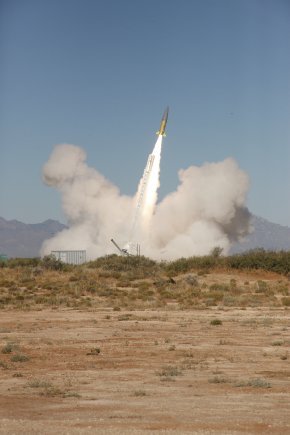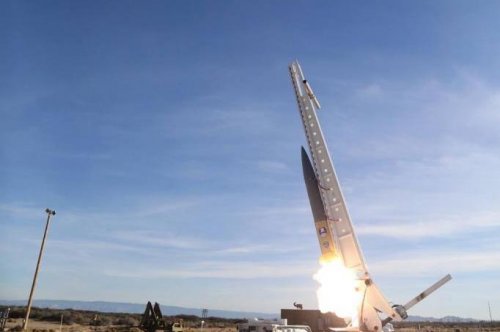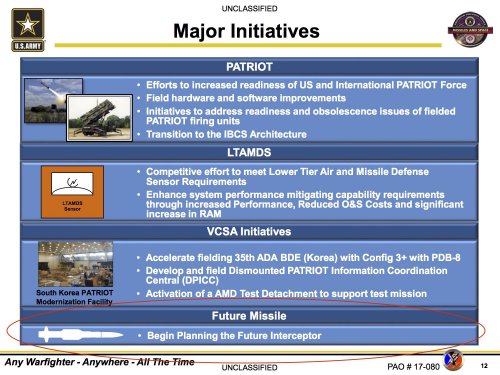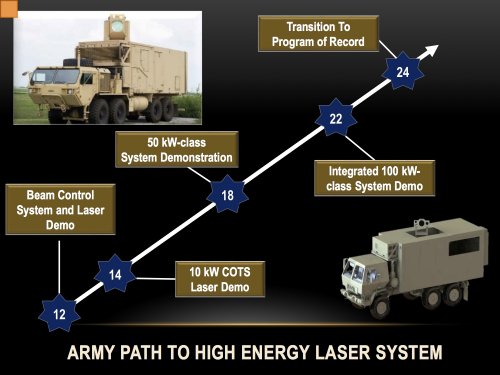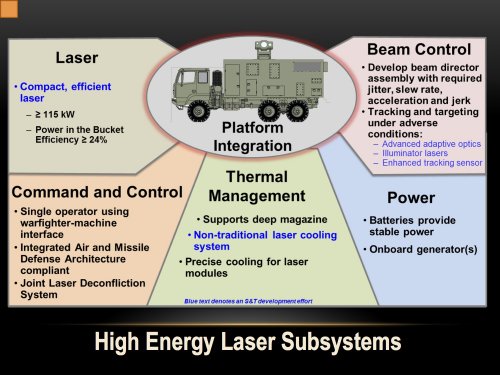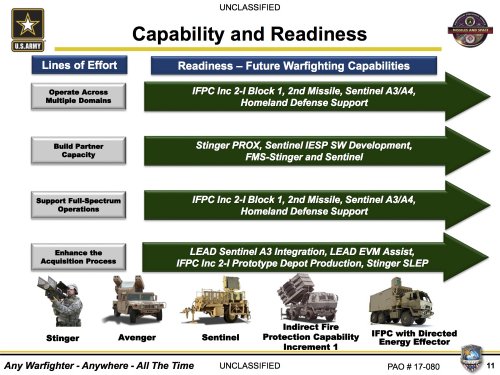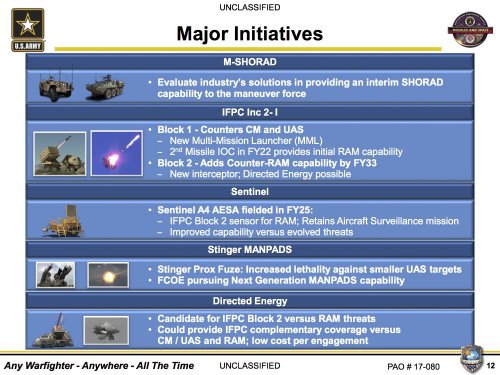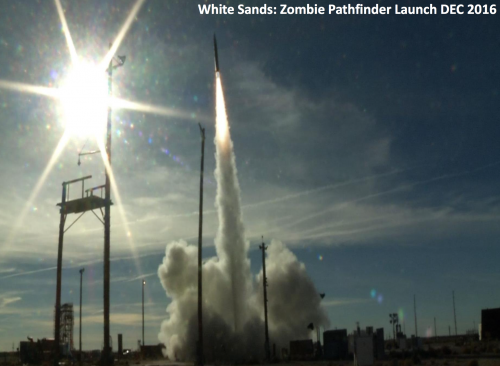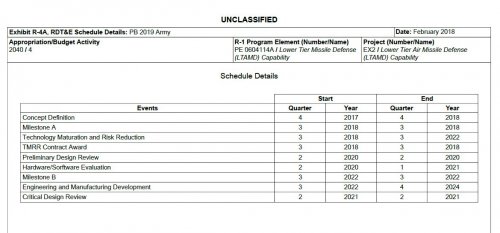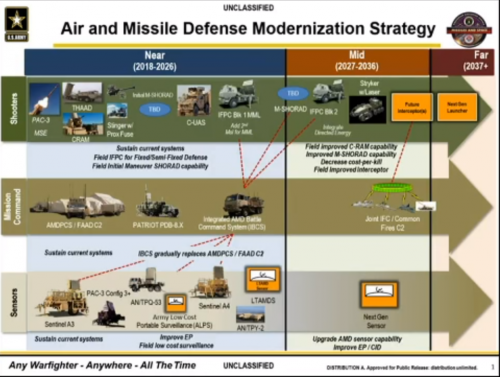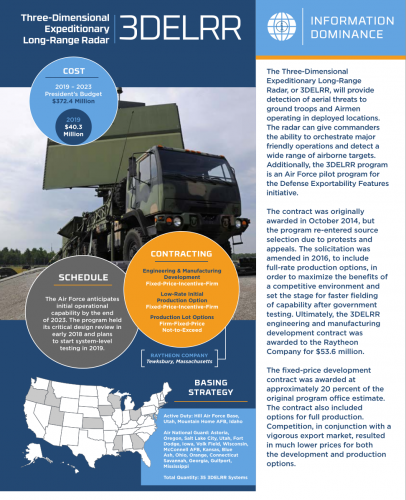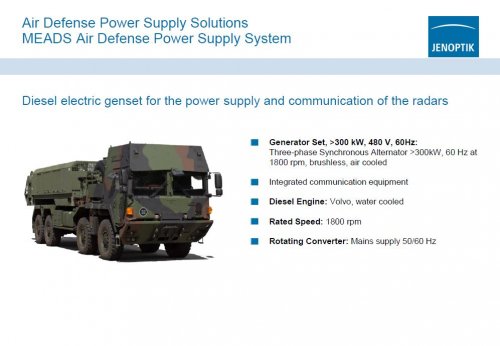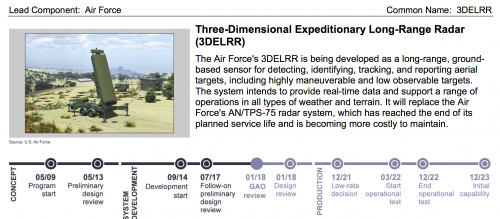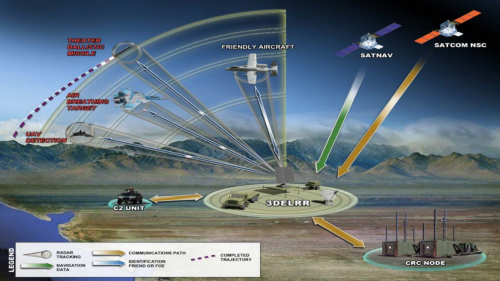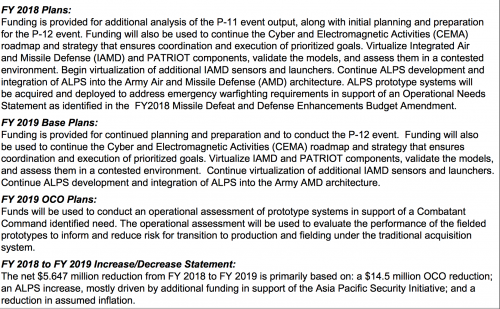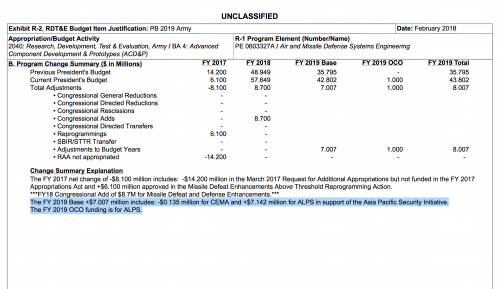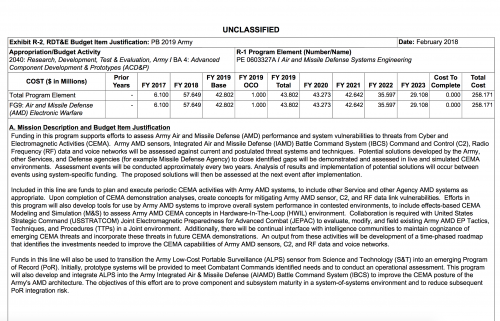You are using an out of date browser. It may not display this or other websites correctly.
You should upgrade or use an alternative browser.
You should upgrade or use an alternative browser.
Patriot SAM replacement
DrRansom
I really should change my personal text
- Joined
- 15 December 2012
- Messages
- 701
- Reaction score
- 300
I think that the SM-6 is a S-400 emulator more than a PAC-3 MSE replacement. The Saudis have announced their interest in S-400s and there is no western land-based system that is equivalent to the 40N6. The SM-6, with booster, would get you closest to that capability.
But I don't think the SM-6 is the right solution. For one, it has a booster which complicates land use. For another, it isn't designed to fit the existing launchers.
The US Army has expressed interest in a low-cost long range interceptor. I wonder if one could be designed to fit a THAAD missile dimensions, but at a lower cost as it wont' be intended for point BMD.
But I don't think the SM-6 is the right solution. For one, it has a booster which complicates land use. For another, it isn't designed to fit the existing launchers.
The US Army has expressed interest in a low-cost long range interceptor. I wonder if one could be designed to fit a THAAD missile dimensions, but at a lower cost as it wont' be intended for point BMD.
bring_it_on
I really should change my personal text
- Joined
- 4 July 2013
- Messages
- 3,637
- Reaction score
- 3,747
Have to differentiate b/w integration with thaad and Patriot. From what I have heard the MSE and the PAC 2 just about max out the current sensor in terms of TBM envelope given the IAMD mission. For AAW there would be advantages with the SM6 on the Patriot but then there are more elegant ways to acheive that even for Raytheon.
bring_it_on
I really should change my personal text
- Joined
- 4 July 2013
- Messages
- 3,637
- Reaction score
- 3,747
Poland – Integrated Air and Missile Defense (IAMD) Battle Command System (IBCS)-enabled Patriot Configuration-3+ with Modernized Sensors and Components
WASHINGTON, Nov. 17, 2017 - The State Department has made a determination approving a possible Foreign Military Sale to Poland for an Integrated Air and Missile Defense (IAMD) Battle Command System (IBCS)-enabled Patriot Configuration-3+ with Modernized Sensors and Components for an estimated cost of $10.5 billion. The Defense Security Cooperation Agency delivered the required certification notifying Congress of this possible sale on November 14, 2017.
The Government of Poland has requested to purchase phase one of a two- phase program for an Integrated Air and Missile Defense (IAMD) Battle Command System (IBCS)-enabled Patriot Configuration-3+ with Modernized Sensors and Components consisting of four (4) AN/MPQ-65 radar sets, four (4) engagement control stations, four (4) Radar Interface Units (RIU) modification kits, sixteen (16) M903 Launching stations adapted, eighteen (18) Launcher Integrated Network Kits (LINKs) (includes two (2) spares), two hundred and eight (208) Patriot Advanced Capabilty-3 (PAC-3) Missile Segment Enhancement (MSE) missiles, eleven (11) PAC-3 MSE test missiles, IBCS software, two (2) future operations – IBCS Engagement Operations Centers (EOCs), six (6) current operations-IBCS EOCs, six (6) engagement operations-IBCS EOCs, fifteen (15) Integrated Fire Control Network (IFCN relays, four (4) Electrical Power Plants (EPP) III, and five (5) Multifunctional Information Distribution Systems/Low Volume Terminals (MIDS/LVTs). Also included with this request are communications equipment, tools and test equipment, range and test programs, support equipment, prime movers, generators, publications and technical documentation, training equipment, spare and repair parts, personnel training, Technical Assistance Field Team (TAFT), U.S. Government and contractor technical, engineering, and logistics support services, Systems Integration and Checkout (SICO), field office support, and other related elements of logistics and program support. The total estimated program cost is $10.5 billion.
This proposed sale will support the foreign policy and national security objectives of the United States by helping to improve the security of a NATO ally which has been, and continues to be an important force for political stability and economic progress in Europe. This sale is consistent with U.S. initiatives to provide key allies in the region with modern systems that will enhance interoperability with U.S. forces and increase security.
Poland will use the IBCS-enabled Patriot missile system to improve its missile defense capability, defend its territorial integrity, and deter regional threats. The proposed sale will increase the defensive capabilities of the Polish Military to guard against hostile aggression and shield the NATO allies who often train and operate within Poland’s borders. Poland will have no difficulty absorbing this system into its armed forces.
The proposed sale of these missiles and equipment will not alter the basic military balance in the region.
The prime contractors will be Raytheon Corporation in Andover, Massachusetts, Lockheed-Martin in Dallas, Texas, and Northrop Grumman in Falls Church, Virginia. The purchaser requested offsets. At this time, offset agreements are undetermined and will be defined in negotiations between the purchaser and contractors.
Implementation of this proposed sale will require approximately 42 U.S. Government and 55 contractor representatives to travel to Poland for an extended period for equipment de-processing/fielding, system checkout, training, and technical and logistics support.
bring_it_on
I really should change my personal text
- Joined
- 4 July 2013
- Messages
- 3,637
- Reaction score
- 3,747
https://www.youtube.com/watch?v=NuAGAREJltA
bring_it_on
I really should change my personal text
- Joined
- 4 July 2013
- Messages
- 3,637
- Reaction score
- 3,747
SMDC provides realistic threats for missile defense tests
The U.S. Army Space and Missile Defense Command/Army Forces Strategic Command Technical Center's Test Execution Support Division successfully launch a Sabre Zombie target at the McGregor Range on Fort Bliss, Texas, into White Sands Missile Range, New Mexico, November 16, to provide a realistic threat ballistic missile target for use in testing advanced missile defense systems.
1 / 1
SHOW CAPTION +
REDSTONE ARSTENAL, Alabama -- One U.S. Army Space and Missile Defense Command/Army Forces Strategic Command team finds better ways for target testing.
Members of the USASMDC/ARSTRAT Technical Center, in support of the Program Executive Office Missiles and Space's Lower Tier Program Office, or LTPO, provided a realistic threat ballistic missile target for use in testing the Patriot Advanced Capability-3 Missile Segment Enhancement, or PAC-3 MSE, advanced missile defense systems.
"We had an excellent team executing this mission," said Kevin Creekmore, SMDC Test Execution Support Division, or TESD acting chief.
The TESD successfully launched a Sabre Zombie target at the McGregor Range on Fort Bliss, Texas, into White Sands Missile Range, New Mexico, November 16.
Creekmore said the target was provided in support of operational testing of the PAC-3 MSE. Preliminary results show the target met all performance objectives and allowed the Patriot system to demonstrate new capabilities that can be provided to the Warfighter. The target carried an on-board hit detection system which provides data to assess the effectiveness of the interceptor's lethality against targets of this class.
"The TESD mission is to provide end-to-end test planning, design, development, integration and test execution, as well as flexible launch platforms and unique low-cost target solutions," Creekmore said. "The Sabre Zombie target is another valuable assets in the low-cost suite of targets that provide solutions for integration missile defense developmental and operational testing, as well as foreign military sales applications.
"This mission was a repeat of a planned Sabre launch in June which was aborted due to an anomalous condition that occurred shortly before scheduled firing," he added. "Following an extensive anomaly investigation, actions were taken to correct the issue. Significant testing was performed to verify the correction which was further validated in the successful target launch."
Creekmore added that the mission was a challenge because it was the third mission supported by the same small team over the previous 12 months. It is a very small government and contractor team and required dedication from the team to support the multiple mission is a short timeframe.
"Throughout my eight-year career at SMDC, I have been a part of 10 ballistic missile flight tests. I have been fortunate enough to serve as the Target Test Director for the last two Sabre missions," said Christopher Cain Crouch, TESD general engineer. "That role is filled with excitement from the beginning of the five-hour countdown right up through the launch, but the most exciting part of the countdown is definitely when the clock hits zero. At launch, you feel the rumble underneath your feet, and your entire body trembles from the rocket motor vibration and the noise. That's the only place in the world where you can get that feeling. It's indescribable."
Crouch said the most important lesson he has learned from testing is that teamwork is critical to mission success.
"No matter how intelligent any one individual may be, he or she cannot launch a missile by themselves," he said. "Every mission is dependent on each team member performing his or her role to the best of their ability. I also believe that communication is key, and that teams can always improve communication processes. We can always improve our communication among our Government team, our contractors, the test range, and our customers.
"We have the most professional team I've ever been a part of," Crouch added. "Everyone on our team works extremely hard and will fill any role with absolutely no complaints. This is attributed to the extremely high-character individuals we have on this team and the leadership."
One team member said the mission was a complete success and they were very pleased with the performance achieved.
"We looked for actuator, fin and battery performance during this test. Everything worked great," said Stephanie Chrisley, TESD general engineer. "We learn something new with each flight test. We get better at performing our checks, build-up and mission execution but it also paves the way for product improvements, such as our two-stage missile.
Sabre is a low-cost target with a wide range of capabilities which can be used for a variety of scenarios and for a variety of customers," she added. "Flexible low-cost targets will allow the Army to test more often. Testing frequently helps us perfect each iteration of updates to our systems and ultimately helps the Warfighter."
Attachments
- Joined
- 3 June 2011
- Messages
- 18,302
- Reaction score
- 12,121
That looks more like a typical ATACMs than past Zombie shots. (Wish I knew the particulars of that Zombie target missile.)
""We learn something new with each flight test. We get better at performing our checks, build-up and mission execution but it also paves the way for product improvements, such as our two-stage missile."
And THIS is why you test.
""We learn something new with each flight test. We get better at performing our checks, build-up and mission execution but it also paves the way for product improvements, such as our two-stage missile."
And THIS is why you test.
Attachments
bring_it_on
I really should change my personal text
- Joined
- 4 July 2013
- Messages
- 3,637
- Reaction score
- 3,747
DrRansom
I really should change my personal text
- Joined
- 15 December 2012
- Messages
- 701
- Reaction score
- 300
bring_it_on said:
That article assumes USAF Air Superiority, I wonder why the author hasn't gotten the memo from upper levels, air superiority is no longer assumed...
Also, those are nice, big, soft, and above ground command centers, I wonder if any UAVs connected to long range rocket artillery have anything to say about that.
bring_it_on
I really should change my personal text
- Joined
- 4 July 2013
- Messages
- 3,637
- Reaction score
- 3,747
That article assumes USAF Air Superiority
The presentation describes the current Army IAMD program. It does not assume anything. AAW is still a part of the Patriot mission set.
I wonder if any UAVs connected to long range rocket artillery have anything to say about that.
Yeah it is amazing that the Army and the Joint Forces have nothing that will be added to the AIAMD and tasked with the C-UAS mission.
https://www.msl.army.mil/Documents/Briefings/CMDS/CMDS%20Public%20Release%20IFPC.pdf
Attachments
bring_it_on
I really should change my personal text
- Joined
- 4 July 2013
- Messages
- 3,637
- Reaction score
- 3,747
sferrin said:That looks more like a typical ATACMs than past Zombie shots. (Wish I knew the particulars of that Zombie target missile.)
Attachments
bring_it_on
I really should change my personal text
- Joined
- 4 July 2013
- Messages
- 3,637
- Reaction score
- 3,747
bring_it_on
I really should change my personal text
- Joined
- 4 July 2013
- Messages
- 3,637
- Reaction score
- 3,747
Since this time last year, engagements with industry have enabled refinement of the schedule to accelerate capability
http://comptroller.defense.gov/Portals/45/Documents/defbudget/fy2019/army/rdte/PB19_RDTE_BA_4.pdf
Attachments
bring_it_on
I really should change my personal text
- Joined
- 4 July 2013
- Messages
- 3,637
- Reaction score
- 3,747
Sweden – Patriot Configuration-3+ Modernized Fire Units
WASHINGTON, FEB. 20, 2018 - The State Department has made a determination approving a possible
Foreign Military Sale to Sweden of Patriot Configuration-3+ Modernized Fire Units for an estimated cost of
$3.2 billion. The Defense Security Cooperation Agency delivered the required certification notifying Congress
of this possible sale today.
The Government of Sweden has requested to buy four (4) Patriot Configuration-3+ Modernized Fire Units
consisting of: four (4) AN/MPQ-65 radar sets, four (4) AN/MSQ-132 engagement control stations, nine (9)
antenna mast groups, twelve (12) M903 launching stations, one hundred (100) Patriot MIM-104E Guidance
Enhanced Missile-TBM (GEM-T) missiles, two hundred (200) Patriot Advanced Capabilty-3 (PAC-3)
Missile Segment Enhancement (MSE) missiles, and four (4) Electrical Power Plants (EPP) III. Also included
with this request are communications equipment, tools and test equipment, range and test programs, support
equipment to include associated vehicles, prime movers, generators, publications and technical
documentation, training equipment, spare and repair parts, personnel training, Technical Assistance Field
Team (TAFT), U.S. Government and contractor technical, engineering, and logistics support services,
Systems Integration and Checkout (SICO), field office support, and other related elements of logistics and
program support. The total estimated program cost is $3.2 billion.
This proposed sale will support the foreign policy and national security objectives of the United States by
helping to improve the security of a strategic partner which has been, and continues to be, an important force
for political stability and economic progress within the Baltic Sea region and across Europe.
The proposed sale of the Patriot missile system will improve Sweden’s missile defense capability. Sweden
will use the Patriot system to defend its territorial integrity and promote regional stability. The proposed sale
will increase the defensive capabilities of the Swedish military and support interoperability with U.S. and
NATO forces. Sweden will have no difficulty absorbing this equipment into its armed forces.
The proposed sale of this equipment and support will not alter the basic military balance in the region.
The prime contractors will be Raytheon Corporation in Andover, Massachusetts, and Lockheed-Martin in
Dallas, Texas. There are no known offset agreements proposed in connection with this potential sale.
Implementation of this proposed sale will require approximately 24 U.S. Government and 32 contractor
representatives to travel to Sweden for an extended period for equipment de-processing/fielding, system
checkout, training, and technical and logistics support.
There will be no adverse impact on U.S. defense readiness as a result of this proposed sale.
bring_it_on
I really should change my personal text
- Joined
- 4 July 2013
- Messages
- 3,637
- Reaction score
- 3,747
https://www.youtube.com/watch?v=lCuZST-98-g
https://www.youtube.com/watch?v=C45FvPPeKPY
https://www.youtube.com/watch?v=C45FvPPeKPY
bring_it_on
I really should change my personal text
- Joined
- 4 July 2013
- Messages
- 3,637
- Reaction score
- 3,747
bring_it_on
I really should change my personal text
- Joined
- 4 July 2013
- Messages
- 3,637
- Reaction score
- 3,747
bring_it_on
I really should change my personal text
- Joined
- 4 July 2013
- Messages
- 3,637
- Reaction score
- 3,747
UPDATED: Marine Corps Nears IOC Decision on G/ATOR Radar System
The Marine Corps is about to declare initial operational capability for its AN/TPS-80 Ground/Air Task-Oriented Radar (G/ATOR) after the service certified that two operational units had the training and logistics in place to sustain the new radar.
Prior to the declaration, the Marine Corps conducted extensive testing with the radars at Wallops Island and Marine Corps Air Station Cherry Point, an interoperability demonstration between G/ATOR and the new Common Aviation Command and Control System (CAC2S) system, and operational assessments with Marine Air Control Squadron (MACS-1) in Yuma and MACS-2 in Cherry Point.
MACS-1 and MACS-2 will continue working with one radar system apiece for operational use, with plans to bring the radar to the spring and fall Weapons and Tactics Instructor Courses (WTI) in Yuma and to an exercise in Norway later this year, deputy program manager Roy Barnhill told USNI News today.
Barnhill said the Marine Corps certified last week that MACS-1 was fully ready to sustain the new system, and the service made a similar certification for MACS-2 about a month ago – which sets up the Marine Corps to declare Initial Operational Capability. Contractor Northrop Grumman said in a news release that the milestone proves “production systems, spares, logistic support items and documentation have been tested and validated through a rigorous process.”
Beginning with Lot 3 units, the service is switching to a Gallium Nitride (GaN) semiconductor to replace the Gallium Arsenide (GaAs) semiconductor used in Lot 1 and Lot 2, and Pentagon acquisition officials decided that initial operational test and evaluation (IOT&E) would have to wait until the GaN technology delivers to the Marines, Barnhill said.The deputy PM added that contractor Northrop Grumman is on track to deliver the three Lot 3 radars with the GaN technology in mid-August. The Marines would spend about a month doing a scaled-down developmental test period, since the hardware and software are all the same as the Lots 1 and 2 units, aside from the semiconductor material. After that month-long testing, MACS-1 would in October conduct initial operational test and evaluation with the G/ATOR Block 1 capability, which covers air defense and air surveillance missions.
The Marine Corps and Northrop Grumman are also pursuing a Block 2 capability, which would track ground-based artillery, rockets and mortars – primarily to identify and attack the source of incoming fires, but also for use during Marine Corps training events, so artillery units can track the accuracy of their outgoing rounds. The remaining four Lot 1 and 2 radars are currently being used for G/ATOR Block 2 development, Barnhill said. Barnhill said Block 2 IOT&E is set for December. That testing will involve the 11th Marine Regiment, an artillery regiment out of Camp Pendleton.As more lots continue to deliver – each lot contract covers three radars – the radars will be spread out to aviation and ground units around the globe. MACS-1 and MACS-2 are the first two aviation units to work with the system, and then 11th Marines and their Camp Lejeune counterpart 10th Marines will take home G/ATORs for their training and operations. MACS-24, a reserve unit in Virginia Beach, and MACS-4 in Okinawa, will also be early recipients of the new radar.
The Marine Corps currently plans to buy 17 G/ATOR systems for the Block 1 mission and 28 for the Block 2 mission, USNI News previously reported.
“Through our close partnership with the Marine Corps, we have been able to achieve this important early fielding milestone,” Roshan Roeder, vice president of the land and avionics C4ISR division at Northrop Grumman Mission Systems, said in the news release.
“We are looking ahead to full-rate production and getting G/ATOR’s unprecedented capabilities to the Marines in the field.”
Attachments
From Raytheon news releases:
Eight U.S. Allies watch newest Patriot upgrade in live fire test
Investment by 14 Patriot partner nations make new technology upgrades possible
http://raytheon.mediaroom.com/2018-03-05-Eight-U-S-Allies-watch-newest-Patriot-upgrade-in-live-fire-test
"PDB-8 is slated for fielding with the U.S. Army and other Patriot partners later this year. It offers:
Enhanced capability against a variety of threats.
An improved Identification Friend or Foe capability.
Improved radar search capability.
Improved target detection and identification.
A redesigned Fire Solution Computer, which enables Patriot to take advantage of the PAC-3 MSE missile capabilities.
An Enhanced Weapons Control Computer which provides up to 50 percent additional processing power for software enhancements to address evolving threats."
Eight U.S. Allies watch newest Patriot upgrade in live fire test
Investment by 14 Patriot partner nations make new technology upgrades possible
http://raytheon.mediaroom.com/2018-03-05-Eight-U-S-Allies-watch-newest-Patriot-upgrade-in-live-fire-test
"PDB-8 is slated for fielding with the U.S. Army and other Patriot partners later this year. It offers:
Enhanced capability against a variety of threats.
An improved Identification Friend or Foe capability.
Improved radar search capability.
Improved target detection and identification.
A redesigned Fire Solution Computer, which enables Patriot to take advantage of the PAC-3 MSE missile capabilities.
An Enhanced Weapons Control Computer which provides up to 50 percent additional processing power for software enhancements to address evolving threats."
bring_it_on
I really should change my personal text
- Joined
- 4 July 2013
- Messages
- 3,637
- Reaction score
- 3,747
I believe PDB-8 is also the baseline version with which IBCS will IOC. Current IBCS testing seems to be happening on PDB-7.
bring_it_on
I really should change my personal text
- Joined
- 4 July 2013
- Messages
- 3,637
- Reaction score
- 3,747
- Joined
- 3 June 2011
- Messages
- 18,302
- Reaction score
- 12,121
bring_it_on said:
Interesting that it says it's on active duty at Hill AFB as well as Mountain Home. ???
bring_it_on
I really should change my personal text
- Joined
- 4 July 2013
- Messages
- 3,637
- Reaction score
- 3,747
Eventually, it will replace all the current TPS-75 inventory.
bring_it_on
I really should change my personal text
- Joined
- 4 July 2013
- Messages
- 3,637
- Reaction score
- 3,747
Riyadh Just Came Under Ballistic Missile Attack Resulting In These Crazy Videos
Still using their legacy Patriot systems with PAC-2s. They should have received a fair number of CRI rounds but an upgraded battery has not yet appeared in any of the intercept videos. One thing that the use of Ballistic Missiles (extended range) by rebel groups and non state/traditional actors has exposed is the need for wide sector coverage if not 360 degree if forward deployed. I just hope that down the road, in addition to LTADMS we (and other Patriot customers) also consider a dedicated surveillance radar to better manage the diverse threats that are going to show up ranging from subsonic cruise missiles, UASs, to Low RCS aircraft, ballistic missiles and hypersonic gliders.
With IBCS and multiple potential sensors currently being developed by the Army's sister services (EASR, G/ATOR, 3DELRR etc), perhaps fielding such a capability could prove cheaper after the AOA having rejected a dedicated surveillance radar for the Patriot on account of cost (though it did determine that a FCR+SR combo offered the best protection/capability).
Still using their legacy Patriot systems with PAC-2s. They should have received a fair number of CRI rounds but an upgraded battery has not yet appeared in any of the intercept videos. One thing that the use of Ballistic Missiles (extended range) by rebel groups and non state/traditional actors has exposed is the need for wide sector coverage if not 360 degree if forward deployed. I just hope that down the road, in addition to LTADMS we (and other Patriot customers) also consider a dedicated surveillance radar to better manage the diverse threats that are going to show up ranging from subsonic cruise missiles, UASs, to Low RCS aircraft, ballistic missiles and hypersonic gliders.
With IBCS and multiple potential sensors currently being developed by the Army's sister services (EASR, G/ATOR, 3DELRR etc), perhaps fielding such a capability could prove cheaper after the AOA having rejected a dedicated surveillance radar for the Patriot on account of cost (though it did determine that a FCR+SR combo offered the best protection/capability).
bring_it_on
I really should change my personal text
- Joined
- 4 July 2013
- Messages
- 3,637
- Reaction score
- 3,747
Raytheon views radar advances as a path for rapid LTAMDS deployment
Like the company’s Air and Missile Defense Radar (AMDR) for the US Navy, LTAMDS uses Radar Modular Assemblies (RMAs), building blocks which can be stacked together to form any size array or bring additional capability into the system.
“How can we take these building blocks, configure them into a sensor that can get into the field rapidly, and have it be fundamentally better than Patriot but notionally less than LTAMDS, with a path to [being] easily upgraded to LTAMDS,” Burgess said.
This interim gap filler capability, based on RMAs, could easily be upgraded to a full-up system at a future date simply by adding more RMAs, he added.
Burgess said he has spoken with the army about an interim gap capability for high-priority locations. “We have been working with the army to really try to look at ‘speed-to-field’ to accelerate and get something into the warfighter's hands and keep that threat overmatch.
“What we are bringing forward is that technology we have been working on for a while in these building blocks and how do you configure them, giving the warfighter an understanding of desired capability from a mission sense, and how that translates into the technology, maturity, and programme planning on the acquisition side,” Burgess added.
The army has credited industry involvement for helping to refine the requirements and accelerate the schedule.
The current Patriot radar, for example, uses a readily available 150 kW power plant. While Raytheon could not divulge the power requirements for LTAMDS, Burgess said it requires more than a 150 kW power plant.
“How do we help the army understand what kind of prime power is available with what is in the inventory versus starting a new approach? How does the performance change as a function of that prime power and availability,” he noted.
It also requires an understanding of mission capability as a function of the prime power available, Burgess added. “What are the trades of being able to achieve that kind of prime power in a mobile situation?”
Attachments
bring_it_on
I really should change my personal text
- Joined
- 4 July 2013
- Messages
- 3,637
- Reaction score
- 3,747
POLAND JOINS PATRIOT TEAM
It is reported today that the government of Poland signed an agreement, i.e. a Letter of Offer and Acceptance (LoA), to purchase Raytheon's PATRIOT Integrated Air and Missile Defence system from the US Army. This LoA paves the way for Poland's PATRIOT force to rapidly reach Initial Operational Capability (IOC), and sets the stage for the US government to begin contract negotiations with Raytheon and its industry partners.
Earlier this year, Poland‘s new defence minister took to Twitter to announce the government was able to negotiate a reduced price to procure PATRIOT air-and-missile defence systems under what it calls the WISLA programme. According to news reports the deal is worth U$4.75 billion with first delivery including 16 launchers, four radar stations and 208 missiles. In their earlier statements, Polish leadership revealed that new air defence systems would be deployed near the border with Russia.
"Poland joins the now 15 nation strong group of countries which trust PATRIOT to defend their citizens, military and sovereignty," Wes Kremer, President of Raytheon Integrated Defense Systems, said. "Poland's procurement of PATRIOT strengthens Trans-Atlantic partnership and security by enabling a common approach to Integrated Air and Missile Defence, and creating jobs in the US and Poland."
bring_it_on
I really should change my personal text
- Joined
- 4 July 2013
- Messages
- 3,637
- Reaction score
- 3,747
Raytheon Lower Tier Air & Missile Defense Sensor solution completes program review
TEWKSBURY, Mass., March 27, 2018 /PRNewswire/ -- Raytheon Company (NYSE: RTN) completed a program and technical review for the Lower Tier Air and Missile Defense Sensor, or LTAMDS, with the U.S. Army. Having led the development of advanced radar technologies for more than 50 years, Raytheon's solution is uniquely prepared to meet the rapid growing needs of today's soldiers. "Air and missile threats are maturing faster than ever before," said Tom Laliberty, vice president of Integrated Air and Missile Defense at Raytheon's Integrated Defense Systems business. "Because soldiers in the field need new technology now, Raytheon is accelerating our potential LTAMDS solution so it is ready for delivery when needed."
Raytheon will support U.S. Army efforts to complete LTAMDS concept development by solidifying performance specifications and refining cost and schedule as the program prepares to enter the Technology Maturation and Risk Reduction phase. The work to date has been focused on delivering an LTAMDS solution to soldiers that meets operational requirements as fast as possible.
Raytheon's prototype technology test bed in Pelham, New Hampshire, continually tests several systems planned for LTAMDS. More than 3,000 testing hours have been completed to date. The testing environment allows the program team to determine key requirements including:
- optimal frequency band
- prime power capacity
- 360o surveillance and fire control
- resiliency in contested environments
- reliability and maintainability
bring_it_on
I really should change my personal text
- Joined
- 4 July 2013
- Messages
- 3,637
- Reaction score
- 3,747
PEO Missiles & Space: Opportunities may exist for IBCS acceleration
The Army's ambitious program to seamlessly integrate sensors and shooters into a battle management system for its missile defense architecture remains behind schedule, but there is potential to shift the time line to the left, according to a service official.
Barry Pike, program executive officer for missiles and space, said Feb. 28 the Integrated Air and Missile Defense (IAMD) Battle Command Platform is undergoing a "deliberate" process.
To date, the Army has demonstrated "the integration of IBCS with the Patriot Post-Deployment Build version 7 software," which was current during the test events. The service has already begun fielding Patriot PDB-8, and combatant commanders require the capability enhancements it provides, he said.
Between now and initial operational capability, slated for fiscal year 2022, the Army intends to integrate the latest configurations of Patriot and Sentinel radar software, as well as upgrading from "the original hardware" that dates to roughly 2010 to a more "production-representative set of hardware" for use in developmental testing and a subsequent limited user test.
"In restructuring the program, there were several factors in that, so the opportunity to bring in Indirect Fire Protection Capability as another shooter in the network. So the integration of that is also sequenced in with the revised program schedule."
The Lower Tier Air and Missile Defense Sensor, billed as an eventual replacement for the Patriot radar within the IBCS architecture, has seen $382 million added to its funding profile with the goal of accelerating the program, Pike said. The service is working with the vendor to determine the potential for acceleration.
Modernization of the Sentinel radar to an A4 configuration, with upgrades to advanced electronically scanned array technology, is "on track to field in the mid '20s," he said.
The restructured program "is building in additional time for test, analyze, fix, test," he said. "So as we experience . . . less-than-satisfactory test results, you build time into the schedule to go find out exactly what those issues are, correct them before you go do the next test."
In a "best-case world," the Army's work to finalize software development would proceed smoothly on the first test, providing "a great opportunity to accelerate the program" as further corrective actions are not required.
He continued, "I don't think budget is holding us back. There may be sequencing-type things. As we go through this deliberate developmental test program and other limited user test, if we see those opportunities are there, obviously there may need to be some re-phasing of funding" to ensure the Army has "production funding to actually get the hardware in place that we can field on an accelerated basis."
When it comes to accelerating development, Pike noted "it's always kind of a risk kind of discussion. So how much testing is good enough?"
bring_it_on
I really should change my personal text
- Joined
- 4 July 2013
- Messages
- 3,637
- Reaction score
- 3,747
I wonder which S&T Surveillance radars (portable) he is referring to at 13:00.
https://www.youtube.com/watch?v=htN5pZVnrVA
https://www.youtube.com/watch?v=htN5pZVnrVA
marauder2048
"I should really just relax"
- Joined
- 19 November 2013
- Messages
- 3,157
- Reaction score
- 926
bring_it_on
I really should change my personal text
- Joined
- 4 July 2013
- Messages
- 3,637
- Reaction score
- 3,747
The GAO gets to use a more relevant graphical depiction while the AF publishes its program highlights with a TPS-75 photo  . Appears to be quite a bit larger than the legacy TPS-75, and given that it operates at a higher frequency it would also require a more powerful generator. I believe this is the first sensor to be compatible with both the CTN and IFCN from the very onset..
. Appears to be quite a bit larger than the legacy TPS-75, and given that it operates at a higher frequency it would also require a more powerful generator. I believe this is the first sensor to be compatible with both the CTN and IFCN from the very onset..
Attachments
bring_it_on
I really should change my personal text
- Joined
- 4 July 2013
- Messages
- 3,637
- Reaction score
- 3,747
Army Low-Cost Portable Surveillance (ALPS): The ALPS passive sensor will integrate into the IBCS network and provide continuous, 360-degree, long-range surveillance against fixed and rotary wing aircraft, UAS, and cruise missile threats.
https://docs.house.gov/meetings/AS/AS29/20180417/108171/HHRG-115-AS29-Wstate-DickinsonJ-20180417.pdf
https://docs.house.gov/meetings/AS/AS29/20180417/108171/HHRG-115-AS29-Wstate-DickinsonJ-20180417.pdf
Attachments
bring_it_on
I really should change my personal text
- Joined
- 4 July 2013
- Messages
- 3,637
- Reaction score
- 3,747
Also from the doc linked above :
Low-Cost Target Development: The Army is engaged in a technology effort to develop a suite of threat-representative targets for lower tier missile defense testing at a substantially reduced cost. Over the past year, we completed three detailed target designs and successfully demonstrated two of the configurations, which leverage excess solid rocket motors. The first Sabre target was successfully launched and intercepted in June 2017, meeting all performance objectives. The second Sabre target was launched and successfully intercepted in November 2017. These missions were critical operational tests of the new PATRIOT interceptor. Development of a two-stage ballistic missile target, known as Black Dagger, continues with a risk reduction launch scheduled for mid-2018. The Black Dagger target is meant to mimic a broader range of short-range ballistic missile threats by achieving longer range, higher altitude, and increased velocity. The Zombie suite of targets has missions planned for PATRIOT and Integrated Air and Missile Defense (IAMD) over the next few years. The goal remains to reduce DoD's overall test execution costs.
Low-Cost Target Development: The Army is engaged in a technology effort to develop a suite of threat-representative targets for lower tier missile defense testing at a substantially reduced cost. Over the past year, we completed three detailed target designs and successfully demonstrated two of the configurations, which leverage excess solid rocket motors. The first Sabre target was successfully launched and intercepted in June 2017, meeting all performance objectives. The second Sabre target was launched and successfully intercepted in November 2017. These missions were critical operational tests of the new PATRIOT interceptor. Development of a two-stage ballistic missile target, known as Black Dagger, continues with a risk reduction launch scheduled for mid-2018. The Black Dagger target is meant to mimic a broader range of short-range ballistic missile threats by achieving longer range, higher altitude, and increased velocity. The Zombie suite of targets has missions planned for PATRIOT and Integrated Air and Missile Defense (IAMD) over the next few years. The goal remains to reduce DoD's overall test execution costs.
seruriermarshal
ACCESS: Top Secret
- Joined
- 4 May 2008
- Messages
- 1,180
- Reaction score
- 573
Saudi Air Force intercepts a ballistic missile in Riyadh's skies launched from Yemen
Attachments
JakobS
I really should change my personal text
- Joined
- 28 October 2016
- Messages
- 13
- Reaction score
- 1
Momentum is slowing down for Patriot here in Sweden.
Several politic parties (military decisions happen in large political agreement here) have now withdrawn there support for pushing the deal through in such a timely maner.
They have discovered that it's probably not so wise to buy the system now a few years before IBCS and the new radar comes online. Especially the lack of 360 degrees cover have sailed up in recent weeks.
The two biggest parties is still behind the agreement to sign the deal before august ends, but there is lot's of signs the deal will be pushed to the future as supports starts to waiver in the conservative party.
Also theres not really any money for it as it is now, if they go through with the deal without allocating more funds for it the army will have to cancel a large amount of exercise in the coming years according to a leaked memo.
Several politic parties (military decisions happen in large political agreement here) have now withdrawn there support for pushing the deal through in such a timely maner.
They have discovered that it's probably not so wise to buy the system now a few years before IBCS and the new radar comes online. Especially the lack of 360 degrees cover have sailed up in recent weeks.
The two biggest parties is still behind the agreement to sign the deal before august ends, but there is lot's of signs the deal will be pushed to the future as supports starts to waiver in the conservative party.
Also theres not really any money for it as it is now, if they go through with the deal without allocating more funds for it the army will have to cancel a large amount of exercise in the coming years according to a leaked memo.
- Joined
- 21 April 2009
- Messages
- 13,732
- Reaction score
- 7,616
https://www.defensenews.com/land/2018/07/11/lockheed-to-double-patriot-missile-production-as-orders-explode/?utm_source=Sailthru&utm_medium=email&utm_campaign=dfn%20dnr%207/11/18&utm_term=Editorial%20-%20Daily%20News%20Roundup
WASHINGTON — Lockheed Martin is planning to double its most advanced Patriot missile’s production in the coming years to deal with exploding orders of the weapon from the U.S. Army and its allies, according to a company executive.
The U.S. Army has dramatically increased its Patriot Advanced Capability-3 Missile Segment Enhancement, or PAC-3 MSE, orders to not just account for full-rate production of the missile but to increase the stockpile on hand as operations overseas continue to eat up the inventory.
The MSE version has a larger, dual-pulse solid-rocket motor and larger control fins that double the missile’s reach and improve performance against evolving ballistic and cruise missiles.
Meanwhile, several new customers abroad have joined the ranks of Patriot air and missile defense owners to include Poland, Romania and Sweden this year. This includes the purchase of a number of the MSE missiles as part of the initial order.
- Joined
- 16 April 2008
- Messages
- 9,585
- Reaction score
- 14,408
bobbymike said:https://www.defensenews.com/land/2018/07/11/lockheed-to-double-patriot-missile-production-as-orders-explode/
Hmm, they might want to solve that problem with exploding orders before they increase production. Or maybe they need to increase production to account for the explosions?
(Sorry, just a bit of silliness)
Similar threads
-
-
FABMS and early versions of SAM D
- Started by uk 75
- Replies: 20
-
Halcon - Argentina's Roland SAM replacement
- Started by batigol
- Replies: 0
-
Thales Lightweight Multirole Missile
- Started by Mercurius Cantabrigiensis
- Replies: 37
-
60s Point Defence Missiles: Mauler and the UK PT 428
- Started by uk 75
- Replies: 4

